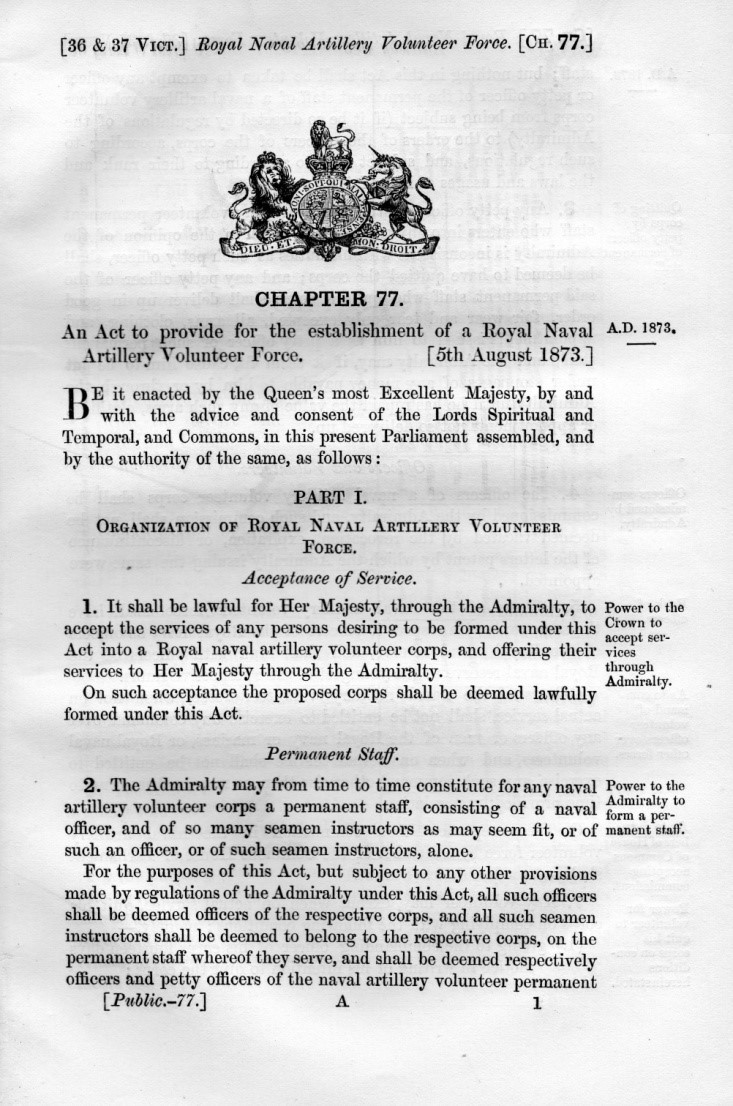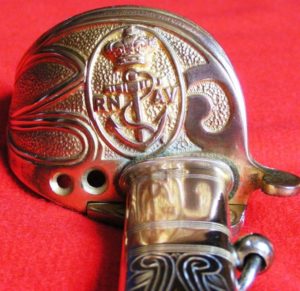- Author
- A.N. Other
- Subjects
- History - pre-Federation
- Tags
-
- RAN Ships
- None noted.
- Publication
- March 2022 edition of the Naval Historical Review (all rights reserved)
By John McGrath
Introduction
The fascinating article by Ron and Ian Forsyth about the Fremantle Naval Volunteers1 opens the way to consideration of the way in which this force fitted into the more general pattern of naval volunteering as it developed in the United Kingdom. As well as this organisational aspect, it is possible to compare the surviving artefacts from these opposite ends of the world. There is a long history of volunteering by people who wished to serve in the armed forces but not full time. The nineteenth century was no exception and numerous naval and military bodies were formed and from among these it is those naval organisations with an artillery function that are considered here.

Naval Artillery Volunteering in the United Kingdom – Royal Dockyard Battalion (RDB)
The first body of Volunteers to embrace an artillery component would seem to have been the RDB. As a result of one of the periodic alarms about French intentions against Britain, this was formed in 1847. The idea of a force to defend naval installations seems to have originated a year earlier with the First Lord of the Admiralty, Lord Ellenborough2. Captain Bartholomew Sulivan RN was appointed as Colonel and Chief of Staff, recruitment was authorised and this raised about 10,500 men divided between infantry and artillery specialisations. In the UK battalions were raised in Deptford, Devonport, Chatham, Pembroke, Portsmouth, Sheerness and Woolwich, while abroad an artillery battalion was raised in Malta. The adjutants were all Lieutenants, Royal Marines, on half-pay and the other officers were senior civilian dockyard employees. The force seems to have been disbanded in about 185
With the man placed in overall charge, Captain Sulivan, being designated the Colonel and with subordinate ranks of Major, Captain and Lieutenant, the organisation was clearly military rather than naval in its structure. This status was emphasised by the lack of the word ‘naval’ in its title and by the uniform. Infantry wore red coats and artillery wore blue coats with red facings and the headgear was the shako.
Royal Naval Artillery Volunteers (RNAV)
Thomas Brassey, MP was the driving force behind the Act of Parliament that authorised the formation of the RNAV which was passed on 5 August 1873, Fig. 1. Brigades were formed in London (1873), Liverpool (1876), Bristol (1881) and the Clyde (1886). It is clear that they were going to provide defences for the important commercial ports that did not enjoy the same level of protection as the RN Dockyards3. They were provided with drill ships. In the naval service, gunnery embraced small arms and edged weapons as well as artillery. So, in addition to learning how to serve the big guns, these volunteers practised musketry, cutlass fighting and the use of such weapons as boarding pikes and boarding axes. A proposal to transfer their control from the RN to the Army met with their hearty disapproval and they were disbanded on 1 April 1892. The RNAV is seen as the precursor to the Royal Naval Volunteer Reserve formed in 1903. The Fremantle Naval Volunteers most closely resembled the RNAV.
Fremantle Naval Volunteers (FNV)
This force was the idea of the colony’s harbour master, Captain George Forsyth, who proposed its establishment in 1878. This was in the middle of the formation of the RNAV Brigades (1873 – 1886) so perhaps he picked up the idea from one or more visiting merchant service captains. The formation was authorised on 10 February the following year. However, unlike the RNAV, the FNV was not backed by legislation, merely by an entry in the Gazette. As well as the FNV it had an interesting range of other names, some of which emphasise the Artillery function: Naval Artillery Volunteers, Fremantle Artillery, Jack Tar Artillerymen. Lacking wholehearted support, the FNV were not as well equipped as their counterparts in the UK. Because there were no naval vessels in the colony they did not have a drill ship and did not learn to serve shipboard artillery. However, the records of their equipment make it clear that they acquired the same range of other weapon skills as their big brothers. This is a tribute to both Forsyth and the men in the unit. The FNV fought against political harassment until it was disbanded on 18 December 1888 and reconstituted as the Fremantle Artillery Corps with officers and men being given Army ranks equivalent to their former naval ranks and rates. This is a very different ending from that of the RNAV.
Surviving artefacts and collecting
This will be confined to the two most similar organisations, the FNV and the RNAV.

FNV
With only a few dozen men involved, it will be a very fortunate collector who finds an item associated with this body. The only known surviving artefact is Captain Forsyth’s sword, Fig. 2, held in the Museum of Western Australia4.
This is a standard naval officer’s sword of the period and on the inner face it bears the etched inscription:
FREMANTLE/NAVAL/ARTILLERY/VOLTRS, within a scroll. The spelling is as it appears on the website which has no image of this inscription.

It is possible that photographs or other illustrations survive and such objects would be highly desirable to collectors.
RNAV
The RNAV was much larger so artefacts associated with this organisation are not uncommon and regularly appear on the open market. The items most likely to be found are the illustrations associated with the RNAV that appeared in the popular illustrated papers of the time. These are relatively common; for instance, on 1 October 2020 there were 30 such on eBay UK ranging in price from about £10 to £20 (AU$18 – 36). Fig. 3 is an example of this type of item.
Officers wore a variant on the RN sword with the initials RNAV placed across the fouled anchor in the cartouche on the guard, Fig. 4, and below the Crown and above the fouled anchor in the design etched on the outer face of the blade. Such a sword would cost about £1,000 (AU$1,800).
Other items of uniform such as epaulettes, sword belts and buttons do occasionally appear at auction but you can expect the prices to be high5,6. Details of uniforms can be found in Note 3.
Summary
The FNV can be seen as an example of the typical enthusiasm for this type of volunteering in the second half of the nineteenth century. However, it differs markedly from its British counterparts in the lack of official support that it enjoyed. The efforts of Forsyth and the other volunteers in persisting in their efforts to provide an efficient and effective force in the face of such indifference and hostility is a tribute to their determination. It is a pity that this force left so few relics to mark its existence.
Notes:
- Forsyth, Ron and Ian, The Ephemeral Commission of the Fremantle Naval Volunteers, Western Australia, 1879 – 1888. Naval Historical Review, Vol. 41, No. 3, September 2020, pp. 8- 13.
- http://www.rmg.co.uk/explore/sea-and-ships/facts/faqs/people/who-were-the-royal-dockyard-volunteers.
- Brassey, Thomas, M.P. The Organisation of the Royal Naval Artillery Volunteers Explained. Longmans, Green, and Co., London (1874).
- https://museum.wa.gov.au/online-collections/content/ W1972.43, accessed 1 October 2020.
- Dix, Noonan Webb, Auction, 8/9 May 2019, Lots 1436 and 1437.
- C&T Auctioneers, 4 February 2020, Lot 585.




